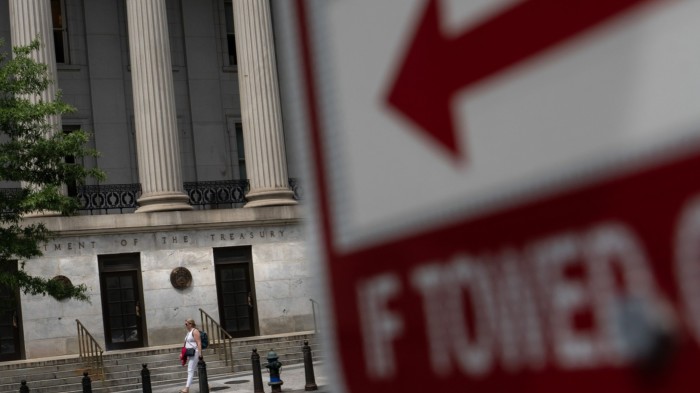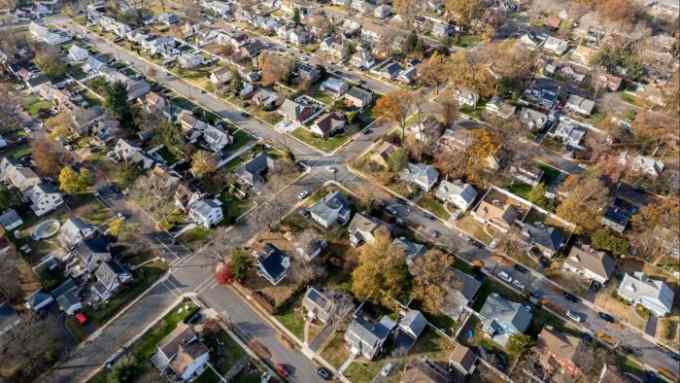‘Higher for longer’ fears fade at first sign of a slowdown

Roula Khalaf, Editor of the FT, selects her favourite stories in this weekly newsletter.
Weaker economic data and a more dovish Federal Reserve this week helped bolster the battered US bond market. But some analysts warn that real relief may be limited, as higher interest rates are here to stay.
Fears that the Fed would keep interest rates “higher for longer” in October drove yields on Treasury bonds to their highest levels in 16 years. The yields on Treasury bonds are sensitive to interest rate expectations, and traders were betting that the strength of the US economy — even in the face of the highest interest rates in a generation — would force the Fed to keep monetary policy tight.
Those fears began to dissipate on Friday after the labor department reported that US employers added 150,000 jobs last month — fewer than forecast by economists at Bloomberg, and roughly half the number added in September. Helped by a dovish-sounding Fed on Wednesday, and the announcement of a slower increase in government borrowing, yields on Treasury bonds fell to their lowest level in over a month.
These falling yields were accompanied by a shift in interest rate expectations. Moves in the futures market on Friday morning suggested that traders had all but eliminated the chance of another interest rate increase this year, while also fully pricing in a rate cut as soon as June. Before the new jobs figures were published, forecasts had been for a cut in July.

But the Fed has explicitly said it will approach each policy decision on a meeting-by-meeting basis, with its deliberations driven by data. And much of that data still shows an economy that remains hot. Inflation has accelerated in recent months thanks to higher petrol prices, and the US economy expanded at a whopping 4.9 per cent in the third quarter.
What’s more, the Fed, while likely to cut interest rates in the event of a recession, may not cut interest rates back to zero, as it did in 2008 and 2020. Analysts suggest differing views over a return to zero interest rates may be contributing to a broader disconnect between the market and the Fed over rate expectations.
“Another way of saying higher for longer is ‘not zero’,” says Torsten Sløk, chief economist at Apollo Global Management. “We’re not going back to zero.”
At its meeting in September, the Fed released its latest Summary of Economic Projections — its so-called dot plot, which reflects members’ forecasts for where interest rates, inflation, and growth will be in the years to come. Official expectations for interest rates were higher than the previous survey in June.
Crucially, the Fed’s estimates for interest rates in the longer term are higher than the market’s — and higher than its own prior estimates — suggesting that officials see a higher “neutral” rate ahead.
This neutral rate — also referred to as R-star — is the Fed’s “Goldilocks” rate: the interest rate that, in the absence of inflationary or deflationary pressures, neither stimulates economic growth nor hampers it. When the neutral rate is in alignment with the actual market interest rates, the economy typically operates at its full potential.
In practice, the neutral rate is an ambiguous number that is hard to pin down. But the Fed’s shifting expectations about long-term interest rates suggest officials see the neutral rate moving higher. And, if inflation persists above the central bank’s 2 per cent target, and officials see the neutral rate at a higher level, the Fed may be less likely to cut interest rates to zero in the event of a recession.
At its meeting in September, the “central tendency” of the Fed survey — which excludes the top and bottom three responses — showed officials saw long-term interest rates in a range of 2.5-3.3 per cent, which was significantly higher than the June projection of 2.5-2.8 per cent.
This is all dramatically different from the period between 2008 and 2019 when the US economy was recovering from the great financial crisis. Interest rates had been cut to near-zero, but inflation remained low, with core PCE (personal consumption expenditures) — the Fed’s preferred gauge of inflation — below its 2 per cent target. And unemployment was high.
“If you really think about why rates were so low from 2008 to 2018, that was because the unemployment rate was very, very high for many, many years,” says Sløk. “It took a long time for the Fed to get to full employment again after the financial crisis in 2008.”
But the state of the US economy today is radically different: the country has recovered from the Covid-19 pandemic far faster than anyone expected; fiscal spending is higher; inflation has been above target, despite the highest interest rates in a generation; and unemployment has stayed low.
“There’s good reason to think that we are no longer in a zero interest rate world,” argues Eric Winograd, director of developed market economist research at AllianceBernstein. “Persistently more expansive fiscal policy probably argues for higher rates, all else equal — both nominal and real. To me, the new normal, whenever the dust settles from this cycle, probably does involve higher interest rates.”

Comments